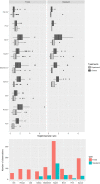Experimental rewilding may restore abandoned wood-pastures if policy allows
- PMID: 32152907
- PMCID: PMC7708577
- DOI: 10.1007/s13280-020-01320-0
Experimental rewilding may restore abandoned wood-pastures if policy allows
Abstract
Large herbivores play key roles in terrestrial ecosystems. Continuous defaunation processes have produced cascade effects on plant community composition, vegetation structure, and even climate. Wood-pastures were created by traditional management practices that have maintained open structures and biodiversity for millennia. In Europe, despite the broad recognition of their biological importance, such landscapes are declining due to land-use changes. This calls for finding urgent solutions for wood-pasture conservation. To test whether introducing an ecological replacement of an extinct wild horse could have positive effects on wood-pasture restoration, we designed a 3-year rewilding experiment. Horses created a more open wood-pasture structure by browsing on seedlings and saplings, affected tree composition via selective browsing and controlled the colonization of woody vegetation in grassland-dominated areas. Thus, rewilding could be a potential avenue for wood-pasture restoration and biodiversity conservation. However, such benefits may not materialize without a necessary paradigm and political shift.
Keywords: Ecological replacement species; Horse browsing; Paradigm shift; Political constrain; Rewilding; Wood-pasture restoration.
Figures



References
-
- Ahti T, Hämet-Ahti L, Jalas J. Vegetation zones and their sections in northwestern Europe. Annales Botanici Fennici. 1968;5:169–211.
-
- Aitchison J. The statistical analysis of compositional data. New York, NY: Chapman and Hall; 1986.
-
- Bakker ES, Gill JL, Johnson CN, Vera FW, Sandom CJ, Asner GP, Svenning J-C. Combining paleo-data and modern exclosure experiments to assess the impact of megafauna extinctions on woody vegetation. Proceedings of the National academy of Sciences of the United States of America. 2016;113:847–855. - PMC - PubMed
-
- Bakker ES, Olff H, Vandenberghe C, De Maeyer K, Smit R, Gleichman JM, Vera FWM. Ecological anachronisms in the recruitment of temperate light-demanding tree species in wooded pastures. Journal of Applied Ecology. 2004;41:571–582.
-
- Bakker ES, Ritchie ME, Olff H, Milchunas DG, Knops JM. Herbivore impact on grassland plant diversity depends on habitat productivity and herbivore size. Ecology Letters. 2006;9:780–788. - PubMed
MeSH terms
LinkOut - more resources
Full Text Sources

